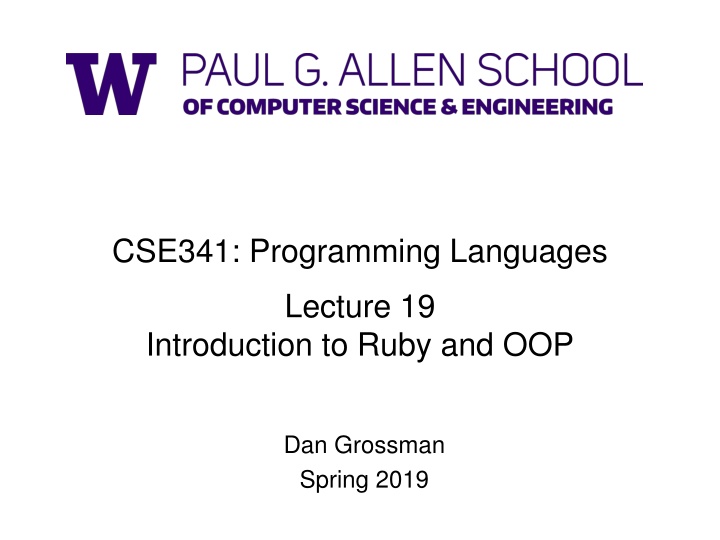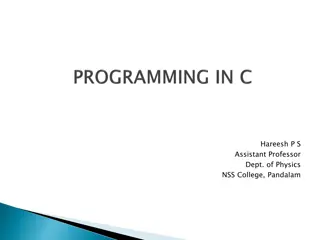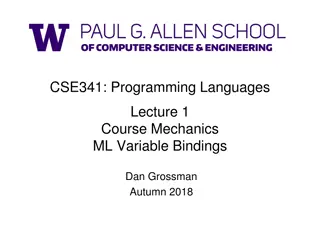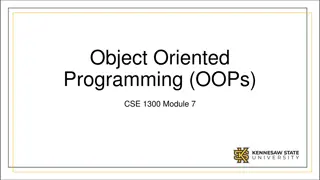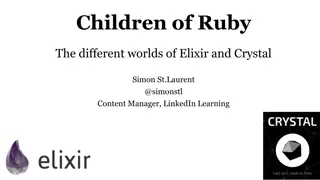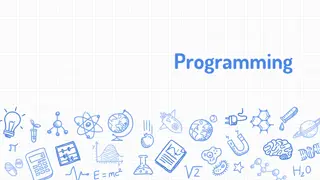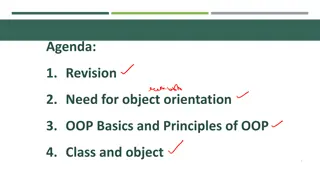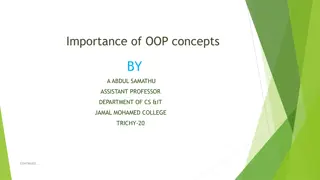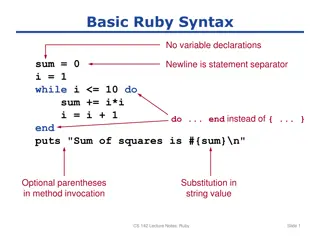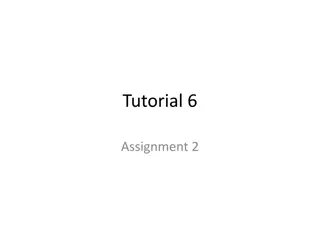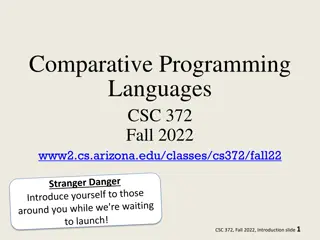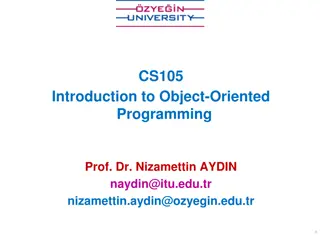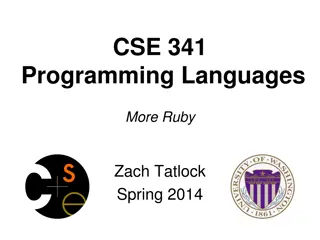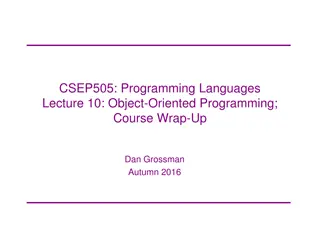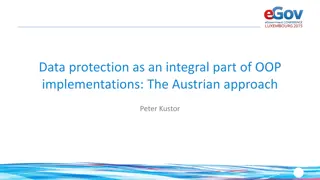Introduction to Ruby and OOP in Programming Languages
This content discusses the fundamental concepts of Ruby programming language focusing on object-oriented programming (OOP). It covers the key characteristics of Ruby such as being pure object-oriented, class-based, dynamically typed, and supporting reflection. The content also highlights the differences between Ruby and other languages like Java and Javascript, emphasizing the dynamic nature of Ruby programming. Additionally, it explores where Ruby fits in the spectrum of object-oriented languages and its historical context compared to Smalltalk. Overall, this provides a comprehensive overview of Ruby as an OOP language with its unique features and applications.
Download Presentation

Please find below an Image/Link to download the presentation.
The content on the website is provided AS IS for your information and personal use only. It may not be sold, licensed, or shared on other websites without obtaining consent from the author.If you encounter any issues during the download, it is possible that the publisher has removed the file from their server.
You are allowed to download the files provided on this website for personal or commercial use, subject to the condition that they are used lawfully. All files are the property of their respective owners.
The content on the website is provided AS IS for your information and personal use only. It may not be sold, licensed, or shared on other websites without obtaining consent from the author.
E N D
Presentation Transcript
CSE341: Programming Languages Lecture 19 Introduction to Ruby and OOP Dan Grossman Spring 2019
Ruby logistics Next two sections use the Ruby language http://www.ruby-lang.org/ Installation / basic usage instructions on course website Version 2.X.Y required, but differences not so relevant Excellent documentation available, much of it free So may not cover every language detail in course materials http://ruby-doc.org/ http://www.ruby-lang.org/en/documentation/ Particularly recommend Programming Ruby 1.9 & 2.0, The Pragmatic Programmers Guide Not free Spring 2019 CSE341: Programming Languages 2
Ruby: Our focus Pureobject-oriented: all values are objects (even numbers) Class-based: Every object has a class that determines behavior Like Java, unlike Javascript Mixins (not [old] Java interfaces nor C++ multiple inheritance) Dynamically typed Convenient reflection: Run-time inspection of objects Very dynamic: Can change classes during execution Blocks and libraries encourage lots of closure idioms Syntax, scoping rules, semantics of a scripting language Variables spring to life on use Very flexible arrays Spring 2019 CSE341: Programming Languages 3
Ruby: Not our focus Lots of support for string manipulation and regular expressions Popular for server-side web applications Ruby on Rails Often many ways to do the same thing More of a why not add that too? approach Spring 2019 CSE341: Programming Languages 4
Where Ruby fits object-oriented (OOP) Ruby Java functional dynamically typed Racket SML statically typed Note: Racket also has classes and objects when you want them In Ruby everything uses them (at least implicitly) Historical note: Smalltalk also a dynamically typed, class-based, pure OOP language with blocks and convenient reflection Smaller just-as-powerful language Ruby less simple, more modern and useful Dynamically typed OOP helps identify OOP's essence by not having to discuss types Spring 2019 CSE341: Programming Languages 5
A note on the homework Next homework is about understanding and extending an existing program in an unfamiliar language Good practice Quite different feel than previous homeworks Read code: determine what you do and do not (!) need to understand Homework requires the Tk graphics library to be installed such that the provided Ruby code can use it Spring 2019 CSE341: Programming Languages 6
Getting started See lec19_silly.rb file for our getting-started program Can run file foo.rb at the command-line with ruby foo.rb Or can use irb, which is a REPL Run file foo.rb with load "foo.rb" Spring 2019 CSE341: Programming Languages 7
The rules of class-based OOP In Ruby: 1. All values are references to objects 2. Objects communicate via method calls, also known as messages 3. Each object has its own (private) state 4. Every object is an instance of a class 5. An object s class determines the object s behavior How it handles method calls Class contains method definitions Java/C#/etc. similar but do not follow (1) (e.g., numbers, null) and allow objects to have non-private state Spring 2019 CSE341: Programming Languages 8
Defining classes and methods class Name def method_name1 method_args1 expression1 end def method_name2 method_args2 expression2 end end Define a class with methods as defined Method returns its last expression Ruby also has explicit return statement Syntax note: Line breaks often required (else need more syntax), but indentation always only style Spring 2019 CSE341: Programming Languages 9
Creating and using an object ClassName.new creates a new object whose class is ClassName e.m evaluates e to an object and then calls its m method Also known as sends the mmessage Can also write e.m() with no space Methods can take arguments, called like e.m(e1, ,en) Parentheses optional in some places, but recommended Spring 2019 CSE341: Programming Languages 10
Variables Methods can use local variables Syntax: starts with letter Scope is method body No declaring them, just assign to them anywhere in method body (!) Variables are mutable, x=e Variables also allowed at top-level or in REPL Contents of variables are always references to objects because all values are objects Spring 2019 CSE341: Programming Languages 11
Self self is a special keyword/variable in Ruby (Same as this in Java/C#/C++) Refers to the current object The object whose method is executing So call another method on same object with self.m( ) Syntactic sugar: can just write m( ) Also can pass/return/store the whole object with just self Spring 2019 CSE341: Programming Languages 12
Objects have state An object s state persists Can grow and change from time object is created State only directly accessible from object s methods Can read, write, extend the state Effects persist for next method call State consists of instance variables (also known as fields) Syntax: starts with an @, e.g., @foo Spring into being with assignment So mis-spellings silently add new state (!) Using one not in state not an error; produces nil object Spring 2019 CSE341: Programming Languages 13
Aliasing Creating an object returns a reference to a new object Different state from every other object Variable assignment (e.g., x=y) creates an alias Aliasing means same object means same state Spring 2019 CSE341: Programming Languages 14
Initialization A method named initialize is special Is called on a new object before new returns Arguments to neware passed on to initialize Excellent for creating object invariants (Like constructors in Java/C#/etc.) Usually good style to create instance variables in initialize Just a convention Unlike OOP languages that make what fields an object has a (fixed) part of the class definition In Ruby, different instances of same class can have different instance variables Spring 2019 CSE341: Programming Languages 15
Class variables There is also state shared by the entire class Shared by (and only accessible to) all instances of the class (Like Java static fields) Called class variables Syntax: starts with an @@, e.g., @@foo Less common, but sometimes useful And helps explain via contrast that each object has its own instance variables Spring 2019 CSE341: Programming Languages 16
Class constants and methods Class constants Syntax: start with capital letter, e.g., Foo Should not be mutated Visible outside class C as C::Foo (unlike class variables) Class methods (cf. Java/C# static methods) Syntax (in some class C): def self.method_name (args) end Use (of class method in class C): C.method_name(args) Part of the class, not a particular instance of it Spring 2019 CSE341: Programming Languages 17
Who can access what We know hiding things is essential for modularity and abstraction OOP languages generally have various ways to hide (or not) instance variables, methods, classes, etc. Ruby is no exception Some basic Ruby rules here as an example Spring 2019 CSE341: Programming Languages 18
Object state is private In Ruby, object state is always private Only an object s methods can access its instance variables Not even another instance of the same class So can write @foo, but not e.@foo To make object-state publicly visible, define getters / setters Better/shorter style coming next def get_foo @foo end def set_foo x @foo = x end Spring 2019 CSE341: Programming Languages 19
Conventions and sugar Actually, for field @foo the convention is to name the methods def foo @foo end def foo= x @foo = x end Cute sugar: When using a method ending in =, can have space before the = e.foo = 42 Because defining getters/setters is so common, there is shorthand for it in class definitions Define just getters: attr_reader :foo, :bar, Define getters and setters: attr_accessor:foo,:bar, Despite sugar: getters/setters are just methods Spring 2019 CSE341: Programming Languages 20
Why private object state This is more OOP than public instance variables Can later change class implementation without changing clients Like we did with ML modules that hid representation And like we will soon do with subclasses Can have methods that seem like setters even if they are not def celsius_temp= x @kelvin_temp = x + 273.15 end Can have an unrelated class that implements the same methods and use it with same clients See later discussion of duck typing Spring 2019 CSE341: Programming Languages 21
Method visibility Three visibilities for methods in Ruby: private: only available to object itself protected: available only to code in the class or subclasses public: available to all code Methods are public by default Multiple ways to change a method s visibility Here is one way Spring 2019 CSE341: Programming Languages 22
Method visibilities class Foo = # by default methods public protected # now methods will be protected until # next visibility keyword public private end Spring 2019 CSE341: Programming Languages 23
One detail If m is private, then you can only call it via m or m(args) As usual, this is shorthand for self.m But for private methods, only the shorthand is allowed Spring 2019 CSE341: Programming Languages 24
Now (see the code) Put together much of what we have learned to define and use a small class for rational numbers Called MyRational because Ruby 1.9 has great built-in support for fractions using a class Rational Will also use several new and useful expression forms Ruby is too big to show everything; see the documentation Way our class works: Keeps fractions in reduced form with a positive denominator Like an ML-module example earlier in course Spring 2019 CSE341: Programming Languages 25
Pure OOP Ruby is fully committed to OOP: Every value is a reference to an object Simpler, smaller semantics Can call methods on anything May just get a dynamic undefined method error Almost everything is a method call Example: 3 + 4 Spring 2019 CSE341: Programming Languages 26
Some examples Numbers have methods like +, abs, nonzero?, etc. nilis an object used as a nothing object Like null in Java/C#/C++ except it is an object Every object has a nil? method, where nil returns true for it Note: nil and falseare false , everything else is true Strings also have a + method String concatenation Example: "hello" + 3.to_s Spring 2019 CSE341: Programming Languages 27
All code is methods All methods you define are part of a class Top-level methods just added to Object class Private in file, public in REPL, more or less (details are weird and not so important to us) Subclassing discussion coming later, but: Since all classes you define are subclasses of Object, all inherit the top-level methods So you can call these methods anywhere in the program Unless a class overrides (roughly-not-exactly, shadows) it by defining a method with the same name Spring 2019 CSE341: Programming Languages 28
Reflection and exploratory programming All objects also have methods like: methods class Can use at run-time to query what an object can do and respond accordingly Called reflection Also useful in the REPL to explore what methods are available May be quicker than consulting full documentation Another example of just objects and method calls Spring 2019 CSE341: Programming Languages 29
Changing classes Ruby programs (or the REPL) can add/change/replace methods while a program is running Breaks abstractions and makes programs very difficult to analyze, but it does have plausible uses Simple example: Add a useful helper method to a class you did not define Controversial in large programs, but may be useful For us: Helps re-enforce the rules of OOP Every object has a class A class determines its instances behavior Spring 2019 CSE341: Programming Languages 30
Examples Add a double method to our MyRational class Add a double method to the built-in FixNum class Defining top-level methods adds to the built-in Object class Or replaces methods Replace the + method in the built-in FixNum class Oops: watch irb crash Spring 2019 CSE341: Programming Languages 31
The moral Dynamic features cause interesting semantic questions Example: First create an instance of class C, e.g., x = C.new Now replace method method m in C Now call x.m Old method or new method? In Ruby, new method The point is Java/C#/C++ do not have to ask the question May allow more optimized method-call implementations as a result Spring 2019 CSE341: Programming Languages 32
Duck Typing If it walks like a duck and quacks like a duck, it's a duck Or don't worry that it may not be a duck When writing a method you might think, I need a Fooargument but really you need an object with enough methods similar to Foo's methods that your method works Embracing duck typing is always making method calls rather than assuming/testing the class of arguments Plus: More code reuse; very OOP approach What messages an object receive is all that matters Minus: Almost nothing is equivalent x+x versus x*2 versus 2*x Callers may assume a lot about how callees are implemented Spring 2019 CSE341: Programming Languages 33
Duck Typing Example def mirror_update pt pt.x = pt.x * (-1) end Natural thought: Takes a Point object (definition not shown here), negates the xvalue Makes sense, though a Point instance method more OOP Closer: Takes anything with getter and setter methods for @x instance variable and multiplies the x field by -1 Closer: Takes anything with methods x= and x and calls x= with the result of multiplying result of x and -1 Duck typing: Takes anything with method x= and x where result of x has a * method that can take -1. Sends result of calling x the * message with -1 and sends that result to x= Spring 2019 CSE341: Programming Languages 34
With our example def mirror_update pt pt.x = pt.x * (-1) end Plus: Maybe mirror_update is useful for classes we did not anticipate Minus: If someone does use (abuse?) duck typing here, then we cannot change the implementation of mirror_update For example, to - pt.x Better (?) example: Can pass this method a number, a string, or a MyRational def double x x + x end Spring 2019 CSE341: Programming Languages 35
